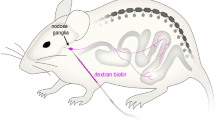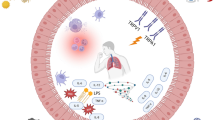Abstract
Rhythmically active medullary slice preparations isolated from neonatal rats (postnatal days 0-3, P0-P3) were used to study the modulation of respiraory rhythmogenesis and hypoglossal (XII) nerve discharge by serotonin (5-hydroxytryptamine, 5-HT) and noradrenaline (NA). 5-HT, NA and their respective receptor agonists and antagonists were applied either to the bathing medium or focally via pressure injection into regions encompassing the pre-Bötzinger complex or XII motoneurons. The effects of endogenously released 5-HT were also studied by chemical stimulation of neurons within the raphe obscurus. The frequency of respiratory burst discharge was increased when 5-HT was applied: (1) to the bathing medium (37±16%; 30 µM; P < 0.05); (2) via pressure injection into the region of the pre-Bötzinger complex (22 ± 14%; < 25 pmol; P < 0.05); or (3) endogenously released in response to activation of neurons within the raphe obscurus via pressure injection of (R,S)-a-amino-3-hydroxy-5-methylisoxazole-4-propionic acid hydro-bromide (AMPA, 34 ± 15%; P < 0.05) or 5-HT (33 ± 5%; P < 0.05). All of these effects were antagonized by bath application of methysergide (30-40 µM). NA caused a reduction of respiratory burst frequency when applied to the bathing medium (40 ± 15%; 100 µM; P < 0.05) or when pressure injected into the region of the pre-Bötzinger complex (22 ± 11 %; < 25 pmol; P < 0.05). These effects were blocked by the bath application of the a2-receptor antagonist idazoxan (2 µM). 5-HT and NA both caused an augmentation of tonic discharge of XII nerves when applied either to the bathing medium or via pressure injection into the XII motoneuron pool. The 5-HT-induced XII nerve tonic discharge was mimicked by the 5-HT2 receptor agonist R(-)2-(2,5-dimethoxy-4-iodophenyl) (DOI.HC1, 5 µM) and blocked by the 5-HT2 receptor antagonist ketanser-ine tartrate (30-40 µM). The NA-induced XII nerve tonic discharge was mimicked by the α1-receptor agonist phenylephrine HC1 (500 µM) and blocked by the α1-receptor antagonist prozasin HC1 (@#@ 1 µM).
Similar content being viewed by others
References
Berger AJ, Bayliss DA, Viana F (1992) Modulation of neonatal rat hypoglossal motoneuron excitability by serotonin. Neurosci Lett 143:163–168
Bhat AM, Scanlon JW, Lavenstein B, Chuang L, Karoum K (1983) Cerebrospinal fluid concentration of biogenic amine metabolites in idiopathic apnea of prematurity. Biol Neonate 43:16–22
Bolme P, Fuxe K (1973) Pharmacological studies on a possible role of central noradrenaline neurons in respiratory control. J Pharm Pharmacol 25:351–352
Champagnat J, Denavit-Saubié M, Henry JL, Leviel V (1979) Catecholaminergic depressant effects on bulbar respiratory mechanisms. Brain Res 160:57–68
Clement ME, McCall RB (1991) Pharmacological characterization of medullary serotonin neurons. Brain Res 542:205–211
DiPasquale E, Morin D, Monteau R, Hilaire G (1992) Serotonergic modulation of respiratory rhythm generator at birth: an in vitro study in rat. Neurosci Lett 143:91–95
Dreteler GH, Wouters W, Saxena PR, Ramage AG (1991) Pressor effects following microinjection of 5-HT1A receptor agonists into the raphe obscurus of the anesthetized rat. Br J Pharmacol 102:317–322
Errichidi S, Monteau R, Hilaire G (1991) Noradrenergic modulation of the medullary respiratory rhythm generator in the newborn rat: an in vitro study. J Physiol (Lond) 443:477–498
Funk GD, Smith JC, Feldman JL (1993) Generation and transmission of respiratory oscillations in medullary slices: role of excitatory amino acids. J Neurophysiol 70:1497–1515
Funk GD, Smith JC, Feldman JL (1994) Development of thy-rotropin-releasing hormone and norepinephrine potentiation of inspiratory-related hypoglossal motoneuron discharge in neonatal and juvenile mice in vitro. J Neurophysiol 72: 2538–2541
Greer JJ, Smith JC, Feldman JL (1991) Role of excitatory amino acids in the generation and transmission of respiratory drive in neonatal rat. J Physiol (Lond) 437:727–749
Hilaire G, Monteau R, Errichidi S (1989) Possible modulation of the medullary respiratory rhythm generator by the nora-drenergic A5 area: an in vitro study in the newborn rat. Brain Res 485:325–332
Jones BE (1991) Paradoxical sleep and its chemical/structural substrates in the brain. Neuroscience 40:637–656
Krowicki ZK, Hornby PJ (1993) Serotonin microinjected into the nucleus raphe obscurus increases intragastric pressure in the rat via a vagally mediated pathway. J Pharmacol Exp Ther 265:468–476
Kubin L, Tojima H, Davies RO, Pack AI (1992) Serotonergic excitatory drive to hypoglossal motoneurons in the decerebrate cat. Neurosci Lett 139:243–248
Kubin L, Reigner C, Tojima H, Taguchi O, Pack AI, Davies RO (1994) Changes in serotonin level in the hypoglossal nucleus region during carbachol-induced atonia. Brain Res 645: 291–302
Lalley PM (1986) Serotonergic and non-serotonergic response on phrenic motoneurons to raphe stimulation in cats. J Physiol (Lond)380:373–385
Lalley PM, Bischoff AM, Richter DW (1994) 5-HT1A receptor mediated modulation of medullary expiratory neurones in the cat. J Physiol (Lond) 476:117–130
Lui G, Feldman JL, Smith JC (1990) Excitatory amino acidmediated transmission of inspiratory drive to phrenic moto-rneurons. J Neurophysiol 64:423–437
Manaker S, Tischler LJ (1993) Origin of serotoninergic afferents to the hypoglossal nucleus in the rat. J Comp Neurol 334: 466–476
Millhorn DE (1986) Stimulation of raphe (obscurus) nucleus causes long-tern potentiation of phrenic nerve activity in cats. J Physiol (Lond) 381:169–179
Monteau R, Morin D, Henniquin SA, Hilaire G (1990) Differential effects of serotonin on respiratory activity of hypoglossal and cervical motoneuron: an in vitro study on the newborn rat. Neurosci Lett 111: 127–132
Morin D (1993) Compared effects of serotonin on inspiratory activity of glossopharyngeal. vagal, hypoglossal and cervical motoneurons in neonatal rat brainstem spinal-cord preparation. Neurosci Lett 160:61–64
Morin D, Hennequin S, Monteau R, Hilaire G (1990) Serotonergic influences on central respiratory activity: an in vitro study in the newborn rat. Brain Res 535:281–287
Morin D, Hennequin S, Monteau R, Hilaire G (1990) Depressant effect of raphe stimulation on inspiratory activity of the hypoglossal nerve: an in vitro study in the newborn rat. Neurosci Lett 116:299–303
Moss IR, Inman JG (1989) Neurochemicals and respiratory control during development. J Appl Physiol 67:1–13
Ozand PT, Tildon JT (1983) Alterations of catecholamine enzymes in several brain regions of victims of sudden infant death syndrome. Life Sci 32:1765–1770
Parkis MA, Baylis DA, Berger AJ (1994) At least two distinct ionic mechanisms underlie the response of hypoglossal motoneurons (HMs) to norepinephrine. Neurosci Abstr 20:1589
Petrouka SJ, Schmidt AW, Sleight AJ, Harrington MA (1990) Serotonin receptor “families” in the central nervous system: an overview. Ann NY Acad Sci 600:104–113
Rodriguez AM, Warburton D, Keens TG (1987) Elevated catecholamine levels and abnormal hypoxic arousal in apnea of infancy. Pediatrics 79:269–274
Scher MJ, Guthrie RD, Krieger D, Sun M, Sclabassi R (1992) Maturational aspects of sleep from birth through early childhood In:Beckerman RC, Brouillette RT, Hunt CE (eds) Respiratory control disorders in infants and children. Williams and Wilkins, Baltimore, pp 352–370
Smith JC, Ellenberger HH, Ballanyi K, Richter DW, Feldman JL (1991) Pre-Bötzinger complex: a brainstem region that may generate respiratory rhythm in mammals. Science 254:726–728
Tork I (1985) Raphe nuclei and serotonin containing systems. In: Paxinos G (ed) The rat nervous system, vol 2, hindbrain and spinal cord. Academic Press, Orlando, pp 43–78
Yamamoto Y, Onimaru H, Homma I (1992) Effect of substance P on respiratory rhythm and pre-inspiratory neurons in the ven-trolateral structure of rostral medulla oblongata: an in vitro study. Brain Res 599:272–276
Author information
Authors and Affiliations
Rights and permissions
About this article
Cite this article
Al-Zubaidy, Z.A., Erickson, R.L. & Greer, J.J. Serotonergic and noradrenergic effects on respiratory neural discharge in the medullary slice preparation of neonatal rats. Pflügers Arch. 431, 942–949 (1996). https://doi.org/10.1007/s004240050089
Received:
Revised:
Accepted:
Issue Date:
DOI: https://doi.org/10.1007/s004240050089




